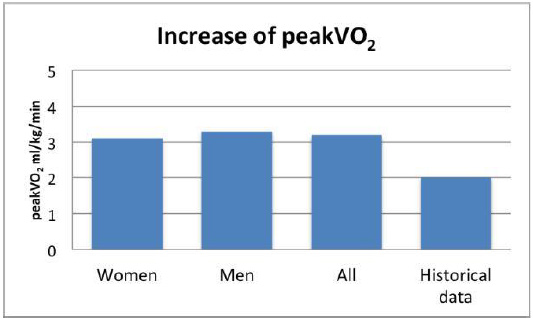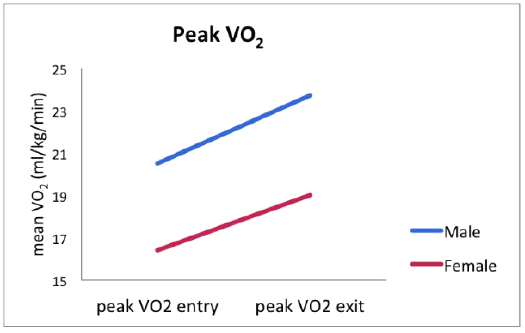Proceeding 
 Creative Commons, CC-BY
Creative Commons, CC-BY
Cardiorespiratory Fitness After A 12-Week Cardiac Rehabilitation Program - Insights in a Contemporary Cohort of Cardiac Patients
*Corresponding author: Veronica Masárová, Cardiovascular Research Institute Basel, University Hospital Basel, Basel, Switzerland
Received: April 23, 2021; Published: May 24, 2021
DOI: 10.34297/AJBSR.2021.13.001823
Abstract
Purpose: Cardiorespiratory fitness (CRF) is a strong predictor of mortality. Cardiac rehabilitation (CR) increases CRF measured by peakVO2 by an average of 2±3.3ml/kg/min according to historical data. Progress in interventional and surgical procedures as well as advances in medical therapies and CR training protocols may result in optimization of CRF gain after a phase 2 CR program. Because data on CRF in contemporary patient populations undergoing CR are scarce, we here report CRF data from our latest patient cohort.
Methods: From January to December 2018 all consecutive patients undergoing a 12-week ambulatory CR program at our institution were included in this analysis. CRF was determined by cardiopulmonary exercise testing. Improvement in CRF was measured as the difference in oxygen uptake at the anaerobic threshold (VO2@AT) and at exhaustion (peakVO2) before and after CR.
Results: 417 predominantly male patients (83% male), mean age 61.5 (SD 12.5) years, completed the 12-week CR program. The majority of patients were included after an acute coronary syndrome (ACS: 65%), followed by patients with chronic coronary syndromes (CCS: 20%), heart failure (7.5%) or valve disease (7.5%). Mean gain of increased CRF was 3,3ml/kg/min (SD 6.5) (VO2@AT) (p=0.0001) and 3,2ml/kg/min (SD 7.0) (VO2max) (p=0.0001). There was no difference between men and women (p=0.127 VO2@AT, p=0.156 VO2max respectively), however, as expected, there was a statistically significant decrease in CRF improvement with increasing age (-0.085ml/kg/min/year, p=0.001).
Conclusion: Though modern therapies reduce length of hospital stay and major cardiovascular events in patients after ACS, CCS and/or heart failure, participation in a 12-week ambulatory CR program still results in a clinically substantial increase in CRF regardless of sex and age. These results in a contemporary real-life-population are better than historical data and match results achieved in recent randomised prospective trials investigating high intensity interval training (HIIT)(Figure 1-3).

Figure 2: Increase of the aerobic threshold measured before and after the 12-week rehabilitation program.

Figure 3: Improvement of CRF measured with peakVO2(ml/kg/min) of our sample compared with historical data.
Keywords: Cardiac rehabilitation; Secondary prevention; Cardiorespiratory fitness




 We use cookies to ensure you get the best experience on our website.
We use cookies to ensure you get the best experience on our website.